Sonuus Voluum – the Most Underrated Analog FX Pedal
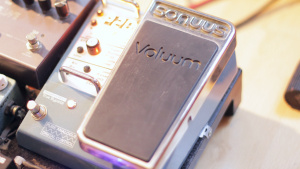
The Sonuus Voluum is one of my favourite effect pedals. In this article, I will cover some basics of what it is and does, and give advice on how to use it combined with a MIDI Contoller, or a Loopswitcher with MIDI functionality (such as my Boss ES-5, and Musicom Lab EFX-LE II).
Table of Contents
Demo Video / tl;dr
The Voluum is a complex device, and this article is a quite long read. Summary:
- Voluum can be your wearless volume pedal, clean boost (up to +40dB!), noise gate, compressor and limiter, ultra-flexible tremolo, and tuner. All in great quality, with fully analog audio path.
- All of this functionality is programmable and can be stored in 100 user presets. You also can switch on/off, and control to some extent, the Voluum’s various FX sections via MIDI.
- So, combined with a MIDI controller (or loopswitcher with MIDI functionality), the Voluum can replace like 6 or 7 individual pedals. Without compromising quality (only in the compressor department, you may find significantly better individual pedals).
- Voluum can also be your MIDI expression pedal (and even MIDI LFO).
- Programming the Voluum gets much easier when connected via USB to a Windows or MacOS computer, using the software editor (unfortunately not yet working with OS X Catalina, as of February 2021).
- Voluum firmware has some quirks, but you can learn how to work around them; described below.
I made a demo video extensively covering the Voluum and its features, check it out below. Then, if you just want to setup your Voluum similar like mine, you can jump to the summary of this article right away.
Sonuus Voluum: What is it?
The Voluum is a wearless analog volume pedal that can go from silence to a +40 dB clean boost. And while the audio path is completely analog, containing not much more than a single VCA (Voltage Controlled Amplifier/ Attenuator), digital control makes this pedal extremely versatile:
- You can program 100 user presets, and recall them via MIDI.
- You get a noise gate, a compressor, and a limiter; all programmable per preset.
- You get the most flexible analog amplitude tremolo pedal which is currently on the market; with 8 different tweakable waveforms, speeds from extremely slow to audio range fast (suitable for ringmodulator-ish sounds), Dual LFO option, and various ways of tempo control: You can program BPMs for a preset, or sync to MIDI Clock with various subdivisions, or tap in a tempo, or use the pedal for footcontrolled tempo.
- You get a wearless volume pedal, with heel and toe volume levels freely programmable per preset, from silence to +40 dB. Or, build a preset with fixed volume level and use the pedal to control other parameters, such as compression strength or tremolo speed. Or, control the volume via MIDI CC.
- You can even use it as a MIDI expression pedal. You can program per preset which CC# is sent on which MIDI channel, and define min/heel and max/toe values.
- Also, you get a great tuner with an easily readable display.
- You can also have auto-volume swells (slow gear).
So, you could call the Voluum an analog multi-effect. But you could also rightfully say: it’s just one effect, a digitally controlled analog VCA. Everything it does could also be done by somebody manually moving a single volume fader ... if that somebody was an android with extremely fast reaction time and ultra precise timing.
Strengths and Weaknesses
Strengths of the Voluum include:
- It is an all-analog, quite transparent sounding device.
- It is a very sturdy and reliable wearless volume pedal and MIDI expression pedal.
- Besides that, it can replace up to 7 other pedals: noise gate, compressor/limiter, tremolo, tuner, clean boost, slow gear and ring modulator. And you can program settings for each of these effects into presets, which you then can recall via MIDI.
- So, you could have presets for a bunch of different tremolo sounds, like: Choppy square wave trem in 16th notes. Smooth classic optical compressor style trem in 8th triplets. Downward sawtooth trem in quarter notes. All synced to MIDI clock.
- And/or, you could program you noise gate for each preset, corresponding with the gain amount on your dirt pedal(s) for that preset.
- Display is large and good to read, can be set bright enough for open air stages in summer, but can also be dimmed.
- You can connect it via USB to a computer, and program it comfortably with the editor app. Unfortunately, currently (Jan 2021) the app is not available for the current Mac OS. It does work with Windows, and with older Mac OS versions.
- You can use it as a USB-to-MIDI interface (with limitations, see weaknesses below).
Weaknesses include:
- There is only one knob on the pedal; plus a footswitch and 5 mini buttons. Display has only 3 LED digits with limited alphanumeric capabilities. This makes it hard to program and operate the Voluum on its own. However, if you use the editor app for programming, and an external MIDI controller (or loopswitcher with MIDI controller functionality) for operation, the Voluum begins to shine.
- There are some bugs in the firmware, especially when you are using MIDI CC commands. More about them, and how to work around them, below.
- Compressor is not very fast; thus, its capability to tame hard transients is limited.
- The Voluum will not pass through MIDI SysEx data; neither from 5 pin MIDI to 5 pin MIDI, nor from USB to 5 pin MIDI (you can find a thread about this in the Sonuus forums here).
- If plugged directly between your guitar and your tube guitar amp, engaging the Voluum at unity gain will slightly change your tone in many cases (depending on guitar and amp impedance and stuff). Most active volume pedals will. However, if used after a buffer, there’s hardly any change to the tone.
How to use the Voluum with a MIDI Controller / MIDI Loopswitcher
You surely can use the Voluum on its own; creating a few useful presets, and selecting them with the on-board footswitch and pedal. You could also connect an external dual footswitch and use that to easily switch up and down Voluum presets. This requires a cable with special wiring; if you’re as bad at soldering as I am, you will probably easily find some DIY pro in some Facebook DIY group, who can solder it for you. Wiring is like this:
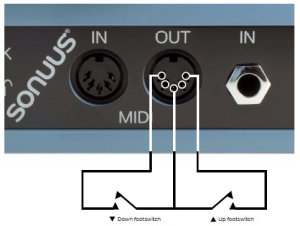
However, to really use the Voluum to its full potential, you should consider an advanced external MIDI controller, such as a Morningstar MC-3/MC-6/MC-8; or a Pirate MIDI Bridge4/Bridge6; or a Disaster Area DMC3/4/6 Gen3. Or alternatively, a loopswitcher with MIDI controller functionality, such as the Boss ES-5/8, Musicomlab EFX-V/EFX-LE/EFX-LEII, Gigrig G3, or RJM PBC 6/10.
Or, to put it the other way around: Buying a Voluum makes most sense if you have, or are planning, a board with some sort of MIDI controller anyhow.
Setting up your MIDI chain
I would always suggest to put your MIDI Controller/Loopswitcher before the Sonuus Voluum in your MIDI chain. This way, the MIDI Controller can send MIDI commands to the Voluum; and the Voluum can still send MIDI expression to the MIDI pedals further down the MIDI chain. (The only reason I could think of to put a Voluum before a Boss ES-5/ES-8 would be: Voluum can only send MIDI expression on one MIDI channel and CC number at a time. Using Assigns on the ES, you could re-route this to control two or more devices on different MIDI channels / CCs simultaneously ... if you really need to do that. I don’t, ever.)
Like, a simplified version of the MIDI chain on my board would be:
Boss ES-5 → Sonuus Voluum → ProStage Remote Wah → Strymon Timeline → Line6 M5 (M5 cannot pass through MIDI, so it needs to be last in any chain).
Now, when I go to some Patch on the ES-5, I can programm it to recall specific presets on each of the 4 MIDI pedals further down the chain (as I’ve explained here and here). Normally, I will make the ES-5 send a MIDI Program Change (PC) command on the Voluum’s MIDI channel, switching the Voluum to my standard volume pedal preset. But when I e.g. want to have a wah pedal, I will create an ES-5 Patch which will
- activate my ProStage Remote Wah in wah mode, and
- activate a Voluum preset which will send MIDI expression to the ProStage Remote Wah.
Likewise, if I need a Whammy pedal, I will create an ES-5 Patch which will
- recall a M5 Preset with the Pitch Glide Algo, programmed to respond to expression pedal/MIDI expression; and
- recall a Voluum preset which will send MIDI expression to the M5 (which means sending CC#1 on the M5’s MIDI channel).
Now, one important thing that you need to be aware of: As mentioned above, the Voluum will not pass through any MIDI SysEx data (still better than the M5, which will not pass thru any MIDI data at all). For normal operation of most MIDI pedals, you don’t need SysEx. But software editors like the Strymon Nixie, or the Boss ES editor, need to send MIDI SysEx to, and receive MIDI SysEx from, the respective pedal. So, whenever I want to use software editors with my ES-5 or Timeline, I need to disconnect their MIDI ports from my pedal board and connect them directly to my computer’s MIDI interface instead.
Actually, I rarely use the ES-5 editor software, since I became very fast programming the ES-5 with the on-board buttons (while I constantly use the Voluum editor software: Voluum is much easier to connect to my Laptop with its USB port; and Voluum is much harder to program with the on-board buttons and knob). But when I do, I want to program the ES-5 and at the same time check the results with my pedal board. That’s possible with a little trick:
- I unplug the MIDI Cables connecting the ES-5 to my pedal board.
- I connect the ES-5 to my computer’s MIDI interface: Computer MIDI out to ES MIDI in, ES MIDI out to computer MIDI in.
- I connect the Voluum to my computer via USB.
- Using the MIDI Ox freeware on my Windows laptop, I route the MIDI in to both the ES editor software and to the Voluum.
Now, I can use the ES editor software, and still operating the ES-5 will affect the MIDI pedals on my board as usual.
PS: Many ES-5/ES-8 user integrate MIDI splitters like the MIDI Solutions Quadra Thru into their rig. From their Loopswitcher’s MIDI Out, they go into the MIDI Splitter. Then, they can connect their computer’s MIDI Out to the Loopswitcher MIDI In; and one of the MIDI Outs from the Splitter goes back to the computer’s MIDI In. While the other Outs of the Splitter go to other pedals on the board. This way, you will keep the ES software editor working even if there’s pedals messing with the SysEx data (like the Voluum does) further down the chain. However, when using a MIDI Splitter, keep in mind that the Voluum can only send MIDI expression to those MIDI pedals which are in a MIDI chain behind the Voluum.
Getting the right Voluum firmware version
When I got my Voluum, I quickly found out that there where MIDI problems; especially sending combinations of Program Change (PC) and Continuous Controller (CC) MIDI commands would lead to strange results. I wrote a detailed post about this in the Sonuus forum, with some bug reports and wishlist items. Sonuus boss James reacted very quickly; they released firmware 1.5.2, which you can download here.
The good news is: This firmware fixes two bugs which I had reported (#1 and #8 from my post linked above). The bad news:
- 1.5.2 is a beta version which never really became an official version; 1.5.1 is still the last officially released firmware.
- The combination of PC and CC is still buggy in 1.5.2; however, buggy in a different way than 1.5.1 – I can live with 1.5.2; in fact, I have gigged for 3 years now with my Voluum on this firmware, without ever having problems. But you need to learn your way around the firmware 1.5.2 quirks.
What do you want to do with MIDI + Voluum?
Still, there is an easy way of using the Voluum with MIDI: Just program presets on the Voluum, and navigate to those presets by sending MIDI Program Change (PC) commands to the Voluum. Some of these presets may contain tremolo effects with their pulse synced to MIDI Clock – still easy. As long as you only want to do this, firmware 1.5.1 will work fine for you, and you will probably not encounter any trouble.
The sea gets more troubled when you want what I want: Being able to use the Voluum as four independent FX pedals – a noise gate, a compressor, a tremolo and volume pedal (or even six, if you count in the limiter and tuner).
My goal when building my current MIDI-fied board – featuring a Boss ES-5 Loopswitcher and the Sonuus Voluum – was: To have the best possible combination of presets (i.e. total recall of combinations of effects and their settings), and instant access / tweaking on the fly.
Enter the Voluum CC commands ...
CC Commands on the Voluum
If you are not familiar with MIDI: You can imagine Continuos Controllers (CC) as sort of a remote control for knob turning/parameter switching. Like, on a Strymon Timeline, CC#9 will control delay repeats (aka feedback). So, sending CC#9 with values slowly increasing from 0 to 127 on the Timeline’s MIDI channel will give the same result as, on the Timeline itself, slowly turning the REPEATS knob clockwise.
MIDI protocol provides CC numbers from 0 to 127 per channel/device. So, you could remote control up to 128 parameters of a pedal. Many devices, including all Strymons, have CC numbers “hardwired” to parameters. Others, including the Eventide H9 and the Sonuus Voluum, have user-assignable CC numbers. On the Voluum, you can assign CC numbers to 11 functionalities:
- A CC for pedal bypassed/active (called “footswitch controller” in the editor app). Me, I use CC#102 for this, since I’m used to “CC#102=0 means bypassed, CC#102=127 means activated” from my Strymon.
- CCs for individually bypassing the five sections of the Voluum: Gate, Compressor, LFO/Tremolo, Volume control, Limiter. (I use CC#79 to #83 for these.)
- A CC for activating the tuner. (I use CC#84)
- For four of the five Voluum sections – Compressor, LFO/Tremolo, Volume and Limiter – you can define a CC that can control various parameters within that section. While you set the aforementioned CCs (for bypassing/activating) globally, you can set these four CCs per preset. Still, I always use the same CC numbers for each preset, to keep things simple: CC#85 (Compressor) to CC#88 (Limiter).
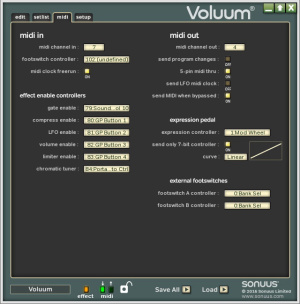
So, what these CC commands can give you is: instant access to switching on/off the various sections of the Voluum (including the tuner) and some parameter control – within a given Voluum preset.
This is great for my goal of combining total recall and instant access: I can pre-program Voluum presets; and while on a certain preset, I can e.g. switch on/off the tremolo section on the fly.
The Voluum’s Hi/Lo Concept
Let’s have a closer look at the Voluum’s parameter control CCs: The Voluum has a rather particular approach here. For each of the four sections Compressor, LFO/Tremolo, Volume and Limiter, you can chose one out of four control modes:
- No Control: Parameters in this section cannot be changed on the fly. You can still switch the section on/off via MIDI CCs; but you cannot tweak its settings via MIDI.
- Pedal: Parameters in this section can be changed with the Voluum’s built-in pedal.
- Envelope: Parameters in this section can react to playing dynamics. You can use this for automatic volume swells (“Slow Gear” effect), or for tremolo speed reacting to your picking dynamics.
Side note: Envelope control mode is not available for the compressor (which makes sense since, by definition, a compressor is envelope controlled anyhow); strangely it is available for Limiter, though. - MIDI: Parameters in this section can react to one user-definable CC#.
If you set any of the Voluum’s FX sections to modes 2 to 4, you will get “Hi” and “Lo” settings for most parameters. Like, you could set the LFO/Tremolo section to “Pedal” control mode. And define that for Hi, tempo will be 300 BPM, and tremolo depth will be at a shallow 3 dB; while for Lo, tempo will be much lower (30 BPM), while tremolo depth will be stronger (7 dB) – as pictured in this screenshot from the Voluum editor app:
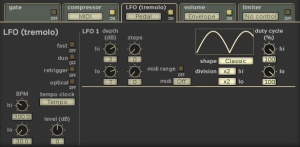
Now, you can operate the pedal, and you will get a deep, slow tremolo at heel position, and a shallow, fast tremolo at toe position.
When you put the control mode of the LFO/Tremolo section to MIDI, you will get the same kind of control via a MIDI CC. The screenshot below shows my standard tremolo setting: Princeton-ish tremolo synced to MIDI Clock at twice the clock pulse rate. In this preset, you can regulate tremolo strength on the fly by sending CC#86 to the Voluum; with value 0 (“lo”) resulting in a 4 dB tremolo amplitude (0 dB to -4dB), and value 127 (“hi”) resulting in a 33 dB tremolo amplitude (0 dB to -33 dB).
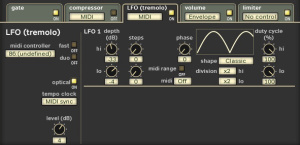
Once you wrapped your brain around this Hi/Lo concept, it’s easy to understand, and to work with. However, there are some inherent limitations:
- You can only chose one of the three control modes per FX section. So, you could e.g. not control compression strength with the built-in pedal, and compression attack time via MIDI, within the same preset. You can also not have envelope controlled tremolo depth (a really nice effect: tremolo won’t mask attacks, but will kick in stronger the more a note decay) and at the same time control tremolo speed with the built-in pedal.
- As you can see in the screenshot, Hi/Lo control is only available for some parameters; like, not for wave shape, and not for (make-up) level. Hence, you will not be able to switch from a smooth sine wave to a choppy square wave trem via MIDI CC within one Voluum preset (you can of course program two different presets for those).
What’s worse: While you can modify tremolo depth on the fly via MIDI CC, you cannot change the make-up level, which you would need to compensate for the psychoacoustic effect that a deep tremolo will sound less loud than a shallow one (or louder, when you use upward dB values rather than downward ones). - Also, the Noise Gate section has no control option at all; so there is no chance to e.g. change the Noise Gate treshold on the fly via MIDI CC. (Which you might want to do when you activate a gain boost within an ES-5 Patch).
Combining PC and CC
MIDI Controllers and MIDI Loopswitchers typically have presets which, on selection, will send out a stack of MIDI data. Like, when I go to a new Patch (preset) on my Boss ES-5, it will send PC and CC commands to all of my MIDI pedals. MIDI is a serial standard, so this stack of data will not be sent simultaneously, but as a machine gun fire of commands. Some pedals have problems in receiving quick consecutive series of PC and CC commands; I heard rumours that some of the early Source Audio MIDI pedals had problems like this. So does the Voluum in firmware version 1.5.1: CCs send right after PCs will mostly get ignored.
So, my typical use of the Voluum might be: I have my standard volume pedal preset, with the FX sections Gate, Compressor and Tremolo all programmed to my favourite default settings, but switched off. Now, on a certain ES-5 Patch, I want to set the Voluum to this preset, and additionally activate the Voluum’s Compressor section. This will fail in Voluum firmware 1.5.1, since the “Activate Compressor” CC command arriving immediately after the “Go to Sascha’s Standard Preset” PC command will be ignored. I could however activate the compressor later within that ES-5 Patch, by only sending the “Activate Compressor” CC (CC#80=127).
This is where firmware 1.5.2 chimes in: This firmware will enable the Voluum to “listen” to MIDI stacks, where a PC is quickly followed by CC messages. But it introduces another strange behaviour: Typically, when you send a PC command to a MIDI pedal, switching from the current preset to, say, preset #10 would recall preset #10 exactly as it was last saved. Thus, resetting any prior changes made via CC messages. Not on Voluum firmware 1.5.2: Here, the pedal “remembers” in some strange way which CCs it received before.
Example:
- I have saved Voluum presets #08 and #10 both with the Voluum Tremolo section turned off.
- Now, while on preset #08, I activate the Voluum Tremolo section, by sending the appropriate CC command from my ES-5.
- Then, I go to a new Patch on my ES-5, which switches the Voluum to preset #10, without sending any additional CC commands.
- What I would expect now is: Voluum preset #10 gets activated just like I saved it – with the Tremolo section turned off.
- What actually happens is: Voluum “remembers” that it had recently received a CC command activating the Tremolo section – hence preset #10 is recalled with active Tremolo.
Once you know this, you can learn how to work with it. The basic concept is: Decide which CC#s you want to use with your Voluum; and then send those CC#s with each of your MIDI controller/loopswitcher’s presets.
Getting your MIDI Programming right with Voluum 1.5.2
First thing you need to do is: Decide which of the 7 “enable controller” CCs – master bypass/engage, bypass/engage for the 5 FX sections, tuner on/off – you want to use in your rig. This is because if you use one of those CCs in any of your MIDI controller/loopswitcher presets, you need to send that CC in each of your MIDI controller/loopswitcher presets to get consistent results.
Most MIDI controllers and loopswitchers can only send a limited amount of PC/CC messages per preset. Like, the ES-5 has 8 Patch MIDIs, each one can send 1 PC and 2 CC messages (for a total of 24 MIDI messages). The Musicom Lab EFX-LEII can only send 12 MIDI messages. Even the brand new top shelf Gigrig G3 switchers can only send 15 (at least with their initial firmware). Having 7 of those eaten up by the Voluum would be really inconvenient.
So, here’s what I do:
- The Limiter only affects extremely high levels. I don’t see any point in switching it on or off within a preset. So, I never use its CC.
- I have the Voluum in a loopswitcher loop, and can bypass it there if necessary (which I almost never do). Hence, also no need to use the CC for master bypass.
- On my current ES-5-based board, the Voluum is my tuner; so I do use the Tuner CC on each ES-5 Patch (mostly as Tuner=Off, that is CC#84=0 with my Voluum global settings; only on my dedicated Mute/Tune Patches with Tuner=On/CC#84=127). However, my future board will be built around a Musicom Lab EFX-LEII loopswitcher (which can only send 12 MIDI commands per preset, not 24 like the ES-5), and feature an HX Stomp; so I will probably find a way to use the Stomp as tuner there, and leave the Voluum tuner off permanently.
- I always leave the Voluum’s volume section on. When I use the Voluum as a volume pedal, of course it needs to be on anyhow. When OTOH I use the Voluum as a MIDI expression pedal, I will set the volume section to No control, or MIDI control (rather than pedal control).
- This leaves me with 3 to 4 CCs which I have to send from my Loopswitcher with each preset to switch on/off: 1. Gate, 2. Compressor, 3. LFO/Tremolo and 4. Tuner.
Additionally, you may wanna send CCs to control parameters on the Compressor, Tremolo/LFO and Volume sections. At least that’s what I want to do:
- Having the option to change compression strength and tremolo depth on the fly;
- plus, on presets where the Voluum’s built-in pedal is not connected to volume control (like, when I used it to control compression depth, or to send MIDI expression to other pedals for wah or whammy effects), I want to control the volume via MIDI CCs.
So, to get my Voluum to do exactly what I want it to do, consistently, I will send a stack of 5 to 7 CC commands after each PC command; telling the Voluum the on/off status of its noise gate, compressor and tremolo sections, as well as compression strengths, tremolo depth and – in case I switch the Voluum to a preset where the built-in pedal will not serve as volume pedal, but control other stuff – volume level.
ATTENTION: There is still one firmware quirk ... Voluum’s Tuner mode will reset CCs in a strange way, which will still compromise the following PC + CCs MIDI command stack received by the Voluum.
I have dedicated Mute/Tune Patches on my loopswitcher: Patches 155, 255, 355 etc.; now, when I go there to tune, and then immediately to some other Patch, the Voluum will often be acting slightly unexpected on that Patch (like, Tremolo is off, though supposed to be on). To be safe, I always take a little detour after tuning, visiting one other Patch on my way from the Mute/Tune Patch to my target Patch. Like, when I go 155 → 115 → 111, then the Voluum will definitely come up with the right settings in Patch 111.
Comparing the Voluum to other Pedals on the Market
There’s several digital pedals which can do most of what the Voluum does; like, the Line6 Helix (or HX Stomp plus expression pedal). However, if you prefer to keep your basic dry guitar or bass signal analog (I do, which I explain here), there’s only few alternatives.
Of course, there’s loads of volume pedals on the market. Only few are wearless. One of the best among the wearless ones is the Lehle Mono Volume. Compared to the Voluum,
- it uses a different, but equally reliable wearless technology for the pedal sensor;
- it also uses a VCA for internal analog volume control;
- both take standard 9V power, both internally transform up voltage to 18V (Lehle) / 30V (Voluum), for more headroom; Lehle accepts a wider range of input voltages and needs way less current (50 mA, while Voluum needs 500 mA);
- it can go from silence to +10 dB (Voluum can go up to +40 dB);
- it’s a single purpose pedal; which you can see as an advantage (simplicity), or disadvantage (you don’t get MIDI, presets, programmable heel/toe volume per preset, noise gate, compressor, tremolo, tuner, MIDI expression ...);
- it comes with a second buffered output, like for a tuner or a second amp (Voluum only has one output);
- it’s about 25% less expensive, at 185 € (Voluum costs 241 €, in Europe, as of January 2021);
- and it’s about 25% smaller, at 9,5 × 26 cm (Voluum is about 19 × 17 cm).
If you want MIDI, presets, flexibility, but yet still a fully analog audio path, there’s not many pedals on the market. There’s the Elektron Analog Drive, the Servus!Pedale Glam ... and most prominently, Chase Bliss Audio (CBA) comes to mind: They have the widest range of MIDI-controlled analog pedals.
So it’s no surprise that the only analog-audio, MIDI-controllable pedals with feature sets roughly similar to the Voluum come from CBA; such as the CBA Gravitas tremolo, or the (unfortunately discontinued) CBA Condor. I only have the Condor here to compare.
Similarities of Sonuus Voluum and CBA Condor include:
- Both offer 100+ presets which you can recall via MIDI.
- Both will give you volume pedal functionality with programmable levels (the Voluum with its built-in wearless pedal; on the Condor, you will have to hook up an external expression pedal), also allowing boost. And both will give you MIDI controlled volume levels from silence to a strong boost.
- Both also can do tremolo.
- Both are high quality pedals, built sturdily and keeping your full audio signal completely analog (and, in a flat setting, mostly unchanged).
Differences:
- Voluum has a display, so you can always see which preset you are on currently.
- Voluum has a built-in high quality wearless pedal; on the Condor, you need to connect an external expression pedal for similar functionality.
- Condor not only can do VCA-based volume control effects like the Voluum, but in addition has a great sounding parametric 3-band EQ/filter section and a (rather mediocre sounding, yet still useable) overdrive section.
- Voluum can do effects based on the envelope of the incoming audio, such as noise gate, compressor, limiter, auto-volume swells (slow gear), envelope trem (tremolo speed controlled by picking dynamics). Condor can do none of this.
- Voluum LFO section is much more flexible, having 8 tweakable waveforms, dual LFO capability, MIDI Clock sync with subdivisions etc. – Condor LFO is much more basic: You get one waveform (triangle), you cannot sync to MIDI clock, you cannot control speed with an expression pedal (you can however control speed via MIDI CC, also with a MIDI expression pedal such as the Voluum).
- Voluum LFO can only control volume, though (and control other devices via MIDI). Condor LFO OTOH can also control the EQ/filter parameters, and thus can be used to create Autowah/LFO filtersweep kind of sounds, even harmonic tremolo (by modulating bass and mid frequencies in opposite directions).
- Condor has all its functionality packed in an incredibly small, yet still easy to operate box with quick direct access to the most relevant parameters (6 dedicated knobs and 3 dedicated switches). Only the special features need to be set with those annoying dip switches CBA has on the north side of all their small pedals.
- Voluum OTOH is rather large, yet still has no dedicated parameter knobs, making tweaking on the fly more difficult. But you get a USB port and a great editor software, which makes tweaking a dream.
- Voluum has a great built-in tuner; Condor doesn’t.
Conclusion: You need both. Well, at least I do :-)
Summary: How I use my Sonuus Voluum
My typical use of the Voluum
- I’ll be on my basic preset, which is #03. There, the pedal will act as a normal volume pedal (heel = silence, toe = 0dB/unity gain).
Noise Gate, Compressor and Tremolo sections are all set to my favourite settings, but switched off. In case of the Tremolo, this will be a Princeton-style vintage Tremolo sound at twice the MIDI Clock pulse sent to the Voluum from my loopswitcher. - Voluum can display the current position of the built-in pedal, on a scale from 0 (heel position) to 100 (toe position). At gigs and rehearsals, I will set up my amps to be at a comfortable volume level with the Voluum at 90. Of course, at gigs with a PA, I will turn up to 100 during sound check once, to make sure the gain on the FoH mixer won’t clip. Then back to 90 for comfortable stage volume. This gives me still some extra headspace to increase volume during the gig. Downside: When doing volume pedal swells with the pedal, I need to be very careful not to become too loud.
- I have an external dual footswitch hooked up to the Voluum as described above for switching up/down presets on the Voluum.
Upward from my basic preset #03, there’s #04 with the exact same settings, except Tremolo is active. #05 to #07 will again be the same, but with Tremolo rates at 3×/4×/6× the MIDI Clock pulse.
Downward from #03, there’s #02 which still has the exact same settings, only that now Tremolo is on a choppy square wave rather than soft vintage trem. #01/#00 will again be the same, but with Tremolo rates at 3×/4× the MIDI Clock pulse.
So, on all loopswitcher Patches using my standard Voluum preset #03 (which is like 70% of my total Patches), by switching Voluum presets up/down, I can quickly access two distinct tremolo sounds, and a variety of common subdivisions related to my master tempo. This will give me 99% of the tremolo sounds I need (only very rarely, I will use dedicated Voluum presets with specific other tremolo sounds). - Voluum Presets #20 to #27 are copies of #00 to #07, respectively (which makes it easy for me to remember which one has what kind of trem settings); only that there, toe level of the volume pedal will be -5 dB rather than 0dB. These are my high gain Patches: I use these to compensate for the increased output level of my main overdrive when gain-boosted. Also, I use them typically with the Voluum’s noise gate activated.
- On most Patches (presets) of my Boss ES-5 loopswitcher, I have programmed two footswitches to be, via MIDI CC sent to the Voluum, dedicated Compressor on/off and Tremolo on/off switches. So I always have direct access to those two effects. (My future board will be built around a Musicom Lab EFX-LEII loopswitcher. There, you cannot program footswitch functionalities per Patch, but only globally. On the upside, you get multiple pages of footswitches. So there, I will globally have 3 switches to turn on/off the Voluum’s Gate, Compressor and Tremolo sections.)
- MIDI CCs also allow me to program any ES-5 patch to have the noise gate, compressor and/or tremolo switched on or off. So, I can use the same Voluum preset #21 for a high gain sound with or without gate, comp and/or square wave trem.
- Further, MIDI CCs allow me to remote control compressor strengths and tremolo depth. I can programm these settings in any of my ES-5 Patches. Also, in some ES-5 Patches, I have set up footswitches to toggle e.g. between two different tremolo depths.
- Voluum presets from #8 to #19 are for more special stuff, like: Using the Voluum as MIDI expression pedal to control my M5, my Prostage Remote Wah, my CBA Condor or my Strymon Timeline. Or slow-gear auto volume swells. Or special trem stuff like sawtooth, dual LFO rhythms, extremely fast ringmodulator sounds. Or using the Voluum LFO section as a MIDI-switchable boost.
- On those Voluum presets where the built-in pedal does not act as a volume pedal – but rather controls stuff like tremolo speed or sends MIDI expression to other pedals – I will set up the two ES-5 footswitches, which normally serve as trem and compressor on/off, to control the volume via MIDI instead; giving me 4 volume levels on tap: Like, footswitch #1 will toggle between 0 dB and -2dB, footswitch #2 will toggle between -4dB and -6dB. Not super flexible, but enough to get my standard wah or whammy sounds to the volume levels I need.
How you prepare your Voluum to be able to do this
- You will need firmware 1.5.2, which you can get here.
- You will of course have to program your Voluum presets as needed. I would suggest creating a template basic preset, and creating you other presets from there. Doing this with the editor software is much easier than on the device itself.
- It will make your life easier if you to set up the MIDI CC numbers on the Voluum in an easy-to-remember way.
Voluum allows you freely define, per preset, which CC number will control parameters in the Voluum’s Comp, Trem and Volume sections. Resist the tempation, keep those numbers strictly identical across presets! Also, I would recommend to keep their functionality identical (which you will easily get when creating all your Voluum presets from one template preset), unless you have special requirements for a certain Voluum preset.
Like, on almost each of my Voluum presets, CC#86 will control tremolo depth with a range from 4dB to 33dB (and nothing else). Now, when I create new Patches on my loopswitcher, I know by heart what MIDI settings I need to make to get a soft, medium, or strong tremolo. - The CC#s to switch sections on/off are set globally. For all CC#s, I recommend to follow the order of the Voluum FX sections as printed on the device (Gate → Comp → Trem → Vol → Limiter); again, makes it easier to remember them.
- So, my personal CC settings are: CCs #79 to #83 will switch on/off those 5 FX sections (I actually never use #82 and #83). #84 will switch the tuner. #85 to #87 will control paramenters on the Comp, Trem and Vol sections respectively. #102 is master bypass, which I also don’t really use.
How to set up your MIDI controller/loopswitcher for this
To get consistent results when using Voluum firmware 1.5.2 with MIDI PC and CC commands, you first need to decide which of the 11 CCs that the Voluum can respond to you actually want to use. On my current board, those are the on/off commands for Gate, Comp and LFO/Trem sections as well as the tuner (which in my setup are #79, #80, #81 and #84 respectively); as well as the parameter control commands for Comp, LFO/Trem and Vol (#85, #86 and #87 in my setup).
Now, each Patch (preset) on my Boss ES-5 loopswitcher will send a PC command, followed by ALL of those 7 CC commands, to the Voluum. Well, except that #87 (volume control) is unnecessary on all those Voluum presets where the built-in pedal already controls the volume; and only needed on special presets where the built-in pedal will control other stuff, like trem speed, or send MIDI expression to other pedals.
So technically, on the ES-5 (same for the ES-8), I need 3 to 4 Patch MIDIs for this:
- Patch MIDI 1 will transmit the Program Change. For Voluum User presets, bank select LSB=1 needs to be sent (otherwise, with LSB=0, you will be in the unchangeable Factory presets bank).
Also, Voluum counts presets from 0 to 127, while ES-5 counts program changes from 1 to 128. My Voluum is set to receive on MIDI channel 7. So, to get to my Voluum standard user preset #03, I will have to set up Patch MIDI 1 on the ES-5 to transmit: Ch=7, LSB=1, MSB=0, PC=4 - Additionally, Patch MIDI 1 will transmit CC#79 and CC#84, to switch the Voluum’s noise gate on (CC#79=127) or off (CC#79=0) as needed for the patch; and the tuner mode off (CC#84=0) ... unless of course I want to create a mute/tune Patch, then it’s CC#84=127.
- Patch MIDIs 2 to 4 must not transmit any program changes, since this is already handled by Patch MIDI 1. So on those three Patch MIDIs, settings on the first menu page have to be Ch=7, LSB=off, MSB=off, PC=off
- Instead, Patch MIDI 2 will tell the Voluum’s compressor section what to do, by sending CC#80 for on (value 127) or off (value 0); and by sending CC#85 with a value of my choice for compressor strength, from soft (0) to heavy (127) as I have defined in my Voluum presets.
- Patch MIDI 3 will do the same for the Voluum’s LFO/tremolo section, with CC#81 doing the switching and #86 controlling tremolo depth.
- Patch MIDI 4 is only needed on those Voluum presets, where the built-in pedal will be disconnected from volume control; there, I will send CC#87 with a value of my choice to set the Voluum to a specific volume.
Other MIDI controllers and loopswitchers work differently; like, grouping one MIDI PC (with bank select MSB and LSB settings) plus 2 CC commands into one “Patch MIDI” is a very Boss-specific thing. Still, the basic concept remains the same for other controllers: Each preset on your MIDI controller/loopswitcher needs to send to the Voluum: a PC, followed by all of the Voluum CCs which you use in any of your MIDI controller/loopswitcher presets. Only this way, you will have consistent results when switching from any arbitrary MIDI controller/loopswitcher preset to any arbitrary other one.
Oh, and after tuning with the Voluum, to be safe, take a detour through another MIDI controller/loopswitcher preset before going to your target preset. The Voluum tuner mode resets CCs in a really strange way, not taking that detour may mess things up.
So, thanks for your attention, and have fun with your Sonuus Voluum :-)

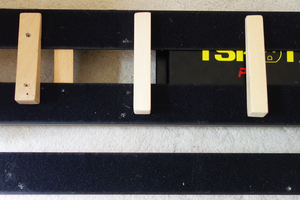
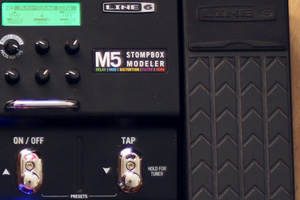
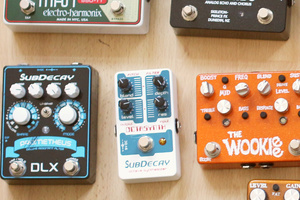
Comments